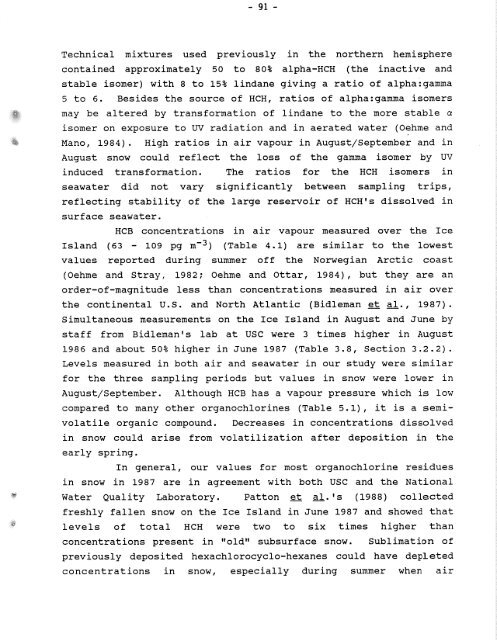Distribution of Chlorinated Hydrocarbon Pesticides and PCBs in the ...
Distribution of Chlorinated Hydrocarbon Pesticides and PCBs in the ...
Distribution of Chlorinated Hydrocarbon Pesticides and PCBs in the ...
Create successful ePaper yourself
Turn your PDF publications into a flip-book with our unique Google optimized e-Paper software.
Technical mixtures used previously <strong>in</strong> <strong>the</strong> nor<strong>the</strong>rn hemisphere<br />
conta<strong>in</strong>ed approximately 50 to 80% alpha-HCH (<strong>the</strong> <strong>in</strong>active <strong>and</strong><br />
stable isomer) with 8 to 15% l<strong>in</strong>dane giv<strong>in</strong>g a ratio <strong>of</strong> a1pha:gamma<br />
5 to 6. Besides <strong>the</strong> source <strong>of</strong> HCH, ratios <strong>of</strong> a1pha:gamma isomers<br />
may be altered by transformation <strong>of</strong> l<strong>in</strong>dane to <strong>the</strong> more stable a<br />
isomer on exposure to W radiation <strong>and</strong> <strong>in</strong> aerated water (Oehme <strong>and</strong><br />
Mano, 1984). High ratios <strong>in</strong> air vapour <strong>in</strong> August/September <strong>and</strong> <strong>in</strong><br />
August snow could reflect <strong>the</strong> loss <strong>of</strong> <strong>the</strong> gamma isomer by UV<br />
<strong>in</strong>duced transformation. The ratios for <strong>the</strong> HCH isomers <strong>in</strong><br />
seawater did not vary significantly between sampl<strong>in</strong>g trips,<br />
reflect<strong>in</strong>g stability <strong>of</strong> <strong>the</strong> large reservoir <strong>of</strong> HCH1s dissolved <strong>in</strong><br />
surface seawater.<br />
HCB concentrations <strong>in</strong> air vapour measured over <strong>the</strong> Ice<br />
Isl<strong>and</strong> (63 - 109 pg m'3) (Table 4.1) are similar to <strong>the</strong> lowest<br />
values reported dur<strong>in</strong>g summer <strong>of</strong>f <strong>the</strong> Norwegian Arctic coast<br />
(Oehme <strong>and</strong> Stray, 1982; Oehme <strong>and</strong> Ottar, 1984), but <strong>the</strong>y are an<br />
order-<strong>of</strong>-magnitude less than concentrations measured <strong>in</strong> air over<br />
<strong>the</strong> cont<strong>in</strong>ental U.S. <strong>and</strong> North Atlantic (Bidleman et &., 1987) .<br />
Simultaneous measurements on <strong>the</strong> Ice Isl<strong>and</strong> <strong>in</strong> August <strong>and</strong> June by<br />
staff from Bidlemanls lab at USC were 3 times higher <strong>in</strong> August<br />
1986 <strong>and</strong> about 50% higher <strong>in</strong> June 1987 (Table 3.8, Section 3.2.2).<br />
Levels measured <strong>in</strong> both air <strong>and</strong> seawater <strong>in</strong> our study were similar<br />
for <strong>the</strong> three sampl<strong>in</strong>g periods but values <strong>in</strong> snow were lower <strong>in</strong><br />
August/September. Although HCB has a vapour pressure which is low<br />
compared to many o<strong>the</strong>r organochlor<strong>in</strong>es (Table 5.1), it is a semivolatile<br />
organic compound. Decreases <strong>in</strong> concentrations dissolved<br />
<strong>in</strong> snow could arise from volatilization after deposition <strong>in</strong> <strong>the</strong><br />
early spr<strong>in</strong>g.<br />
In general, our values for most organochlor<strong>in</strong>e residues<br />
<strong>in</strong> snow <strong>in</strong> 1987 are <strong>in</strong> agreement with both USC <strong>and</strong> <strong>the</strong> National<br />
Water Quality Laboratory. Patton g& &.Is (1988) collected<br />
freshly fallen snow on <strong>the</strong> Ice Isl<strong>and</strong> <strong>in</strong> June 1987 <strong>and</strong> showed that<br />
levels <strong>of</strong> total HCH were two to six times higher than<br />
concentrations present <strong>in</strong> lloldll subsurface snow. Sublimation <strong>of</strong><br />
previously deposited hexachlorocyclo-hexanes could have depleted<br />
concentrations <strong>in</strong> snow, especially dur<strong>in</strong>g summer when air

















